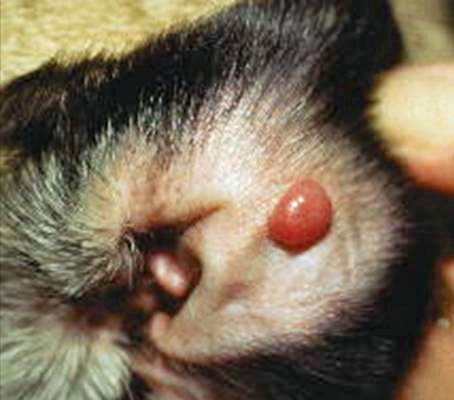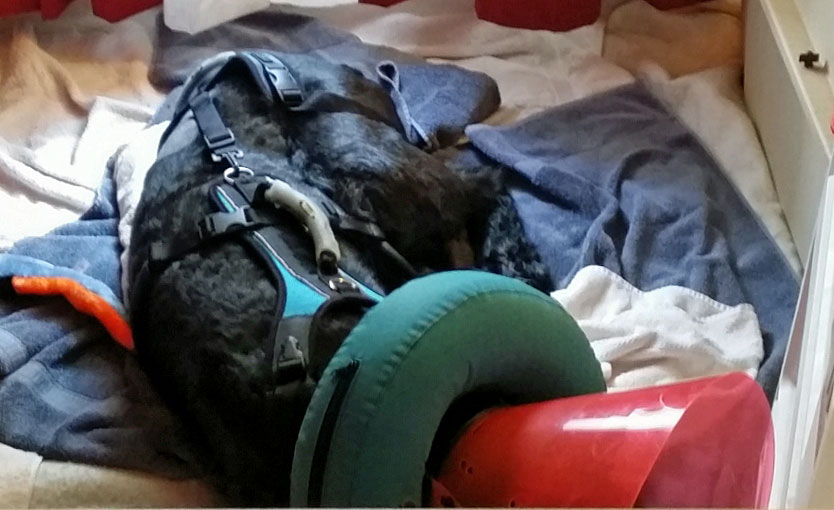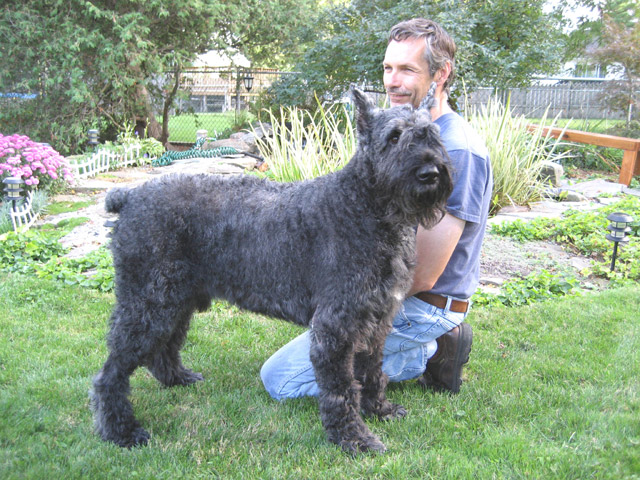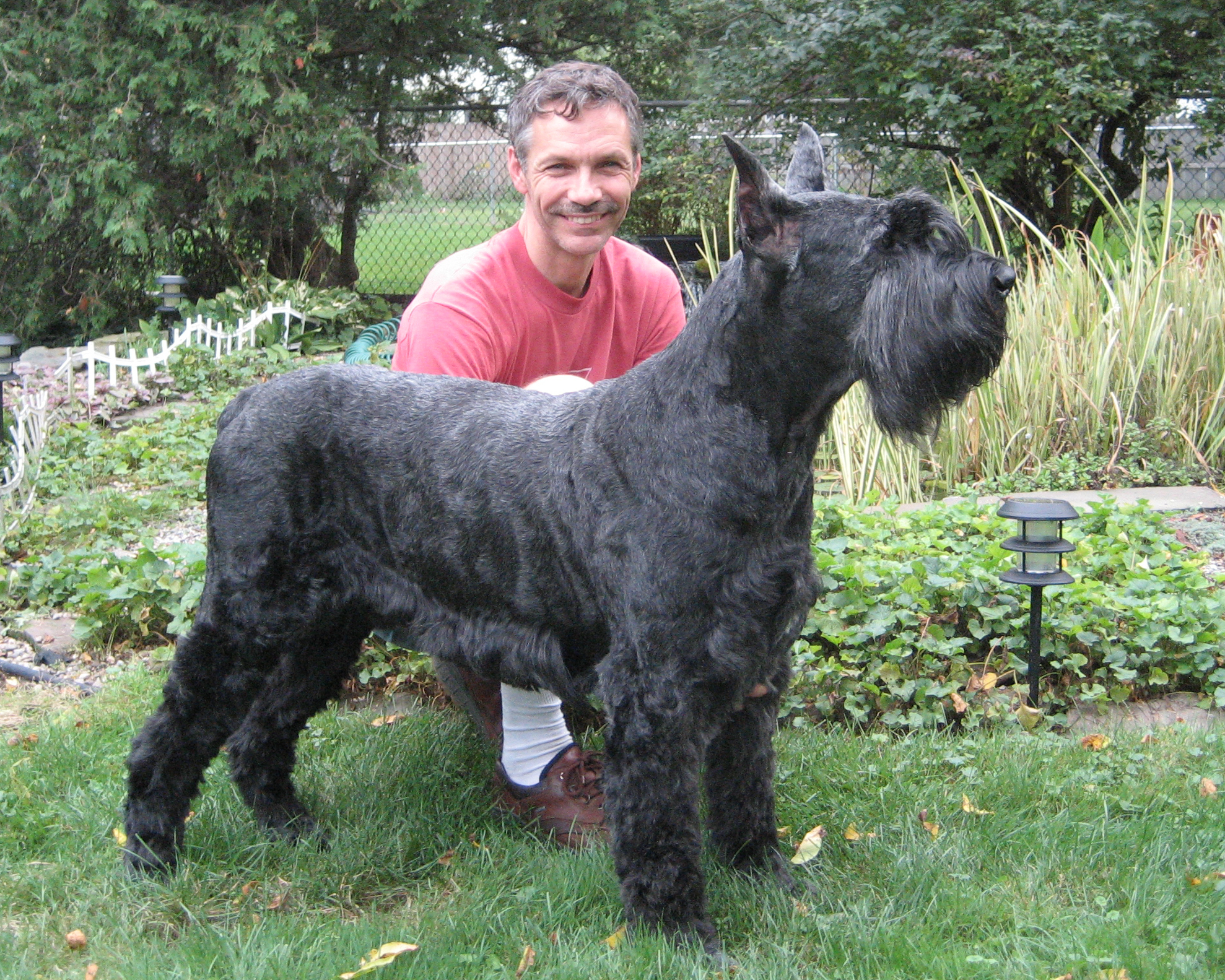- Second Chance AIHA ›
- Forums ›
- AIHA Dog ›
- AIHA-Just Diagnosed
Wendy,
Chance had these things too, most likely from the Atopica (cyclosporine). He was on this drug for a very long time and was on a very high dose for about 2 months. One particular growth on his neck crusted and looked pretty darn awful. It finally came off by itself and did bleed like this. It eventually healed just fine. He didn’t have any on the paws, but those are a known side effect also. He had a very serious non-regenerative anemia. If we had not treated him with this drug, he would have died.
These skin growths can be one of several things: canine sebaceous cyst or adenitis, pyoderma, crusty dermatitis, papillomas, histiocytoma, granulomatous mass or lesion, cutaneous cyst, epulis (gums), benign epithelial tumor and hemangioma.

Benign Histiocytoma
I know they all sound horrible. But they are generally benign skin growths of one kind or another.
Why does this happen? Cyclosporine works by interfering with the very rapid growth of certain cell types of white blood cells that are generally known to be the cause of this autoimmune attack on the red blood cells.
These white blood cells are called T-Cells or more affectionately Killer T-Cells and are part of a group of WBC called lymphocytes. They are made in the bone marrow and are shuffled off to the Thymus where they mature and receive instructions on how to protect the body. Thus the “T” in T-Cells.
They normally are very good at taking instructions, but like many young know-it-all kids, they can go rogue and become warriors against the body. They are active in many autoimmune conditions not only in dogs but in humans as well.
T-Lymphocytes are “kissing cousins” of other blood cell types, they don’t follow the same reproductive path. So the T-Cells can destroy other types of white blood cells along with the RBC and they can even do this inside the bone marrow. Chance had this condition, immune-mediated neutropenia, along with non-regenerative anemia. This was a severe loss of his other WBC types and RBC. It was a very dangerous situation as it left him open to many infections and profound anemia. He was on many different antibiotics, including cephalexin which was very helpful in keeping his skin problems under control. Unless Frank has an allergic reaction, this will be very helpful.
So in the case of AIHA the T-Cells begin specifically attacking RBC. What do RBC have in common with skin cells? Ah, glad you asked. Both cell types reproduce and change out very frequently and rapidly. So the T-Cells will also upset the rapid growth of skin cells causing all these crazy looking skin things. Is it dangerous? Not necessarily. Just unsightly. Rarely they can develop infections and very rarely become malignant.
How do I know all this? I have read the Atopica product insert and the research testing that was done on dogs prior to this drug being approved for use in dogs. In those tests they gave dogs either 1-3-5 times the maximum recommended target dose. Those dogs getting 5x the max dose had more associated side effects than the 1x group. See Atopica product insert:
https://www.secondchanceaihadogs.com/medication-resources/#mg
However, here’s the rub. Atopica, even at it’s worse (and any vet would be stupid to use more than the recommended dose) doesn’t have as many serious side effects as prednisone which negatively affects every function in the body and can make humans and dogs very ill after long term high dose use.
If a dog’s life depends on using “something” to suppress the immune system, why not use the one that has fewer side effects and targets only the T-Cells, not the whole immune system?
Not every dog does well on Atopica. Some can never get over the stomach problems and they may even develop colitis. If, after herculean efforts to try to adjust for these problems, the dog just can’t stomach it, then it must be discontinued.
When you are also using 1 or 2 other immunosuppressive drugs simultaneously the dermal (skin) side effects can be significant. Chance, having hair, lost his coat and didn’t grow it back until months later. He developed raw huge sores on his elbows, and of course these growths. He looked awful.
But his coat returned and here is his picture, a year after he recovered, with a dark black shiny coat. These ARE pictures of the same dog! (And the same human)
I want to reassure you that these growths are probably just that, benign, and you must protect them from becoming infected. Your vet will know what to look for.
We owners go into these terrible diseases with one dog and we come out the other end in recovery with a slightly different dog. These dogs, however, still have their wonderful sense of how joyous life is and they could care less how they look.
I know how discouraged you are right now but please stay cheerful for his sake. He will mirror your emotions, if you are sad he will think he has done something wrong.
By the way I use a blow up pillow collar in addition to a shorter and smaller cone so my dogs can still have peripheral vision. It works quite well. Willie had knee surgery in March and this is how we protected his wound from the first day.

my best
patrice
Hi Wendy
A belated very Happy 1st Birthday to beautiful Frank.
I’m sorry you have had this latest scare with the skin infection and cellulitis and very glad he is now on antibiotics. Fingers crossed they will soon kick in and he will start to feel better. Patrice has given you lots of awesome information which makes it easier to understand why these things can happen.
Best wishes,
Mary and Mable x
Thank you for the information. I really appreciate it.
I just received a call from our vet with the blood work results.
This is the following information I received:
-PCV went down to 31.6% he was at 34%
-White Blood Count is high (because of infection)
-Liver count is high
-Thyroid is low
Vet mentioned something about bone marrow issues and the possibility of having to keep him at the hospital. (Which we cannot afford and it breaks my heart to think about the “e” word.My heart is breaking little by little)
She wants to drop his prednisone to 1 (20mg tablet in the morning) and 1/2 (10 mg at night).
She is contemplating of having him take Atopica every other night.
The antibiotics will only be for 14 days.
I need to check his temperature every night, if it is above 102.5 degrees, I must call her the next morning to let her know.
I am hoping to get a copy of the results tomorrow. Oh, and she also mentioned that she wasn’t sure why he was still in the low 30s. I thought it was normal for dogs to remain in a certain range for some time?
I am hoping that the vet will consult once more with Dr. Dodds. I am actually going to call her right now to let her know that she can still do that.
Any ideas in the mean time about bringing down the liver counts? Do you think putting him back on sucralfate will help him?
Frankenstein’s mom
Wendy, sorry if I’m asking the same thing over and over. Is Frank on Thyroxine? If not he should absolutely be put on it, even more important that he’s been tested low, but even if he wasn’t low, it helps our AIHA dogs to get their marrow producing those reds.
With the liver, it’s totally normal to see the liver enzymes go up, that’s because the liver is having to cope with the high dose pred. Frank needs to go on Denamarin (SAMe and milk thistle). That will help the liver to cope with the drugs and you’ll see an improvement in the enzymes. At the very least, a very high quality milk thistle will help. You just need to be careful as there’s a lot of rubbish on the markets. That’s why we like Denamarin. It’s a specific dose that’s been tested for dogs.
With the reduction in the PCV, that’s not a huge drop. I know you don’t want to see it go down, but usually you allow about 5 plus or minus because different things will affect the reading. How hydrated they are. If Frank had enough water in his system, the reading WILL go down. If he’s dehydrated, the reading goes up. So don’t panic about that just yet.
I’m worried about the reductions though. I understand the high dose pred could be making the infection harder to fight, but it’s much safer to not reduce anything until they’ve been in the normal range for a little while and then do it slowly.
How is Frank acting?
Vally & Bingo
xxx
Wendy, you need sam-e for the liver, although high counts ARE normal during this – did she say *how* high?
There is something called Denamarin that your vet likely carries, or you can order it online (I don’t believe you need a prescription), however, it is expensive, especially for a large dog. But it will work.
The alternative is buying straight sam-e liquid meant for humans, this is also expensive, but may work out to be a little cheaper. The one I have saw used most is by Cellfood, they have a lot but you’ll want just the straight sam-e, it is on Amazon
http://www.amazon.com/Lumina-Health-SAM-e-Liquid-Formula/dp/B0019K99OI/ref=sr_1_1?rps=1&ie=UTF8&qid=1440211366&sr=8-1&keywords=cellfood+same-e
I cannot remember dosage, but if you’d like to try this, I can help you look. Then you would want to combine that with milk thistle, this is what I used for Sassy:
http://www.amazon.com/Starwest-Botanicals-Organic-Turmeric-Powder/dp/B001A1PYHW/ref=sr_1_5?s=hpc&ie=UTF8&qid=1440211011&sr=1-5&keywords=milk+thistle+powder&pebp=1440211012246&perid=03VW6480QTGR9CR57ZXX
Those are basically the two ingredients in the Denamarin that work. The difference is that you can give quite a bit more of it in it’s raw for vs. the pills which have a strict limit.
Sassy’s PCV also dipped like that when she had a bad UTI.
She likely wants to reduce the meds to help him fight the infection. I have no advice on this part, or much else. :( I hope someone else will be along shortly to give you some more advice. Definitely, get your dr to consult with dodds some more. I know that thyroid can be low while on high dosage of prednisone, also. There is a way to test “around” the pred, though – do you know if they did that? I discovered Sassys was low during this as well. She is taking thyroid meds now.
Woops, I linked the wrong product for the milk thistle – thats turmeric – sorry! Here it is:
http://www.amazon.com/gp/product/B002DXU0TI?psc=1&redirect=true&ref_=oh_aui_detailpage_o03_s00
No, Frank is not on Thyroxine.
I will purchase the items right now. Now that I think about it, I made a purchase for the SAMe and Milk Thistle and I haven’t received it yet. With all of the issues going on I forgot about it. But I will go ahead and buy it once more since, who knows, someone may have taken it off my front porch. It would not be the first time.
Frank has been really active. He sleeps a lot and it has been really hot at night. Usually is the high 70s mid 80s. His temperature tonight was 103.1 degrees. Last night it was 103.4 degrees.
Overall, Frank seems to be sleeping the usual hours. He gets ups to follow me around and he looks less bloated.
Lastly, even though she told me to go down on the pred, I haven’t. I am still giving him 1 tablet in the morning and at night. I believe it is too drastic of a drop.
Frankensteins mom
Hi Wendy
Yes – you CANNOT lower the pred/atopica until he gets into normal range – even then, it needs o be done slowly to prevent a relapse. These are the “rules” with this disease, I’m afraid. Sorry to repeat myself. Any infection slows the recovery rate, so please don’t worry if he doesn’t come up too quickly. Once the infection has gone, he will get better. You also need thyroxine, you really do. I sent you Dr Dodds thyroxine information ages ago for your vet – if you want me to e-mail it to you again, that’s no problem.
Many of our dogs have had bone marrow failure – my dog included. At Frank’s PCV, he does not need hospitalisation, so I don’t understand why they are saying that- & don’t let them push you into a bone marrow biopsy either. The treatment is EXACTLY the same regardless of it being IMHA or bone marrow failure.
Love Sheena x



















































































































































































































































































































